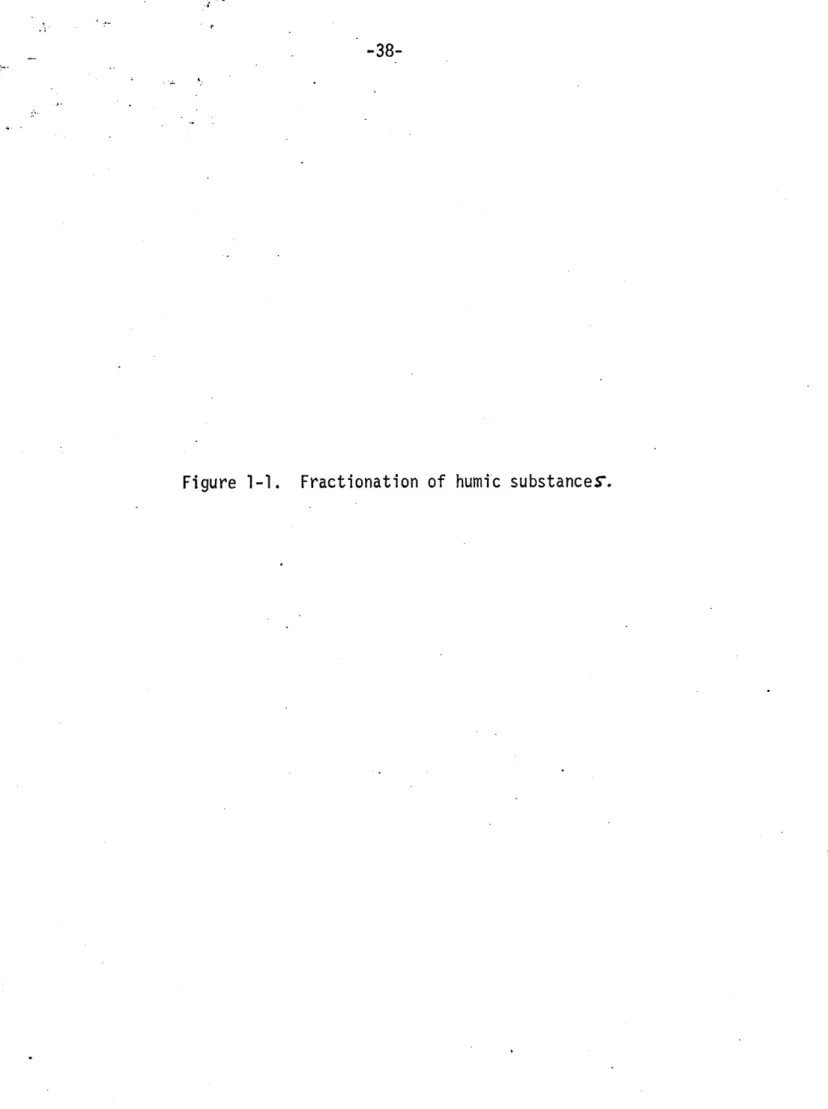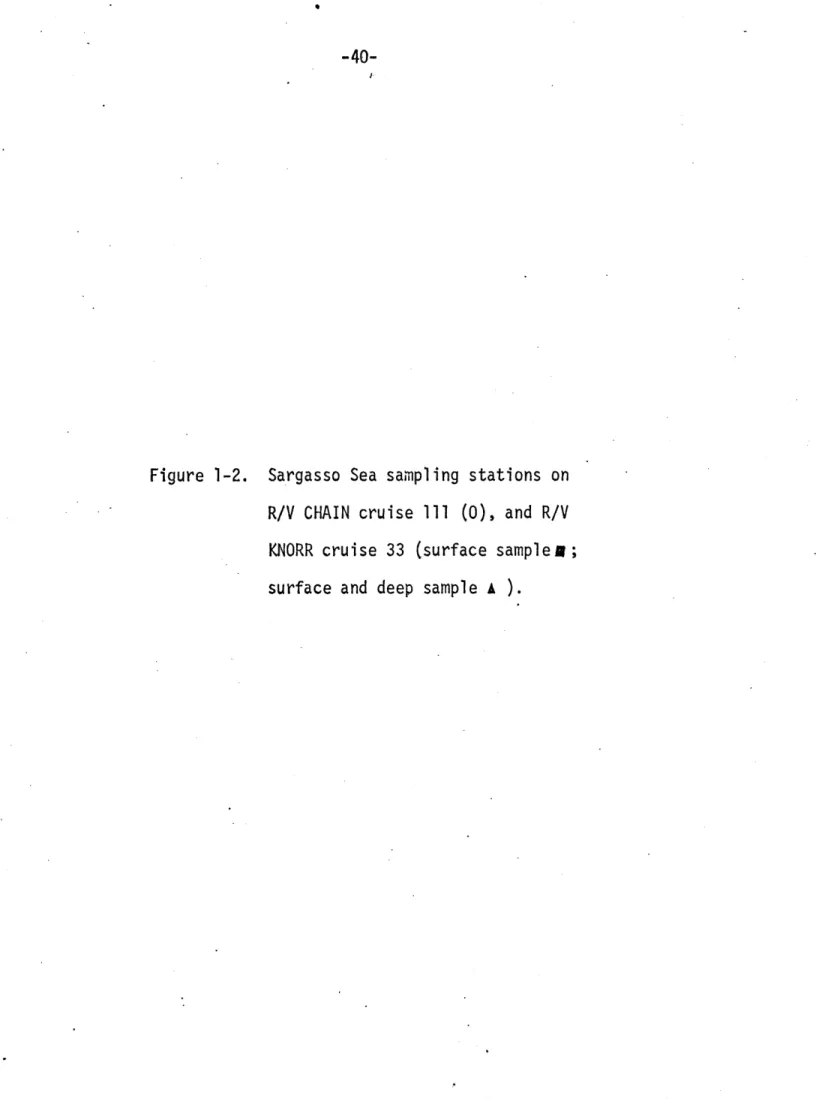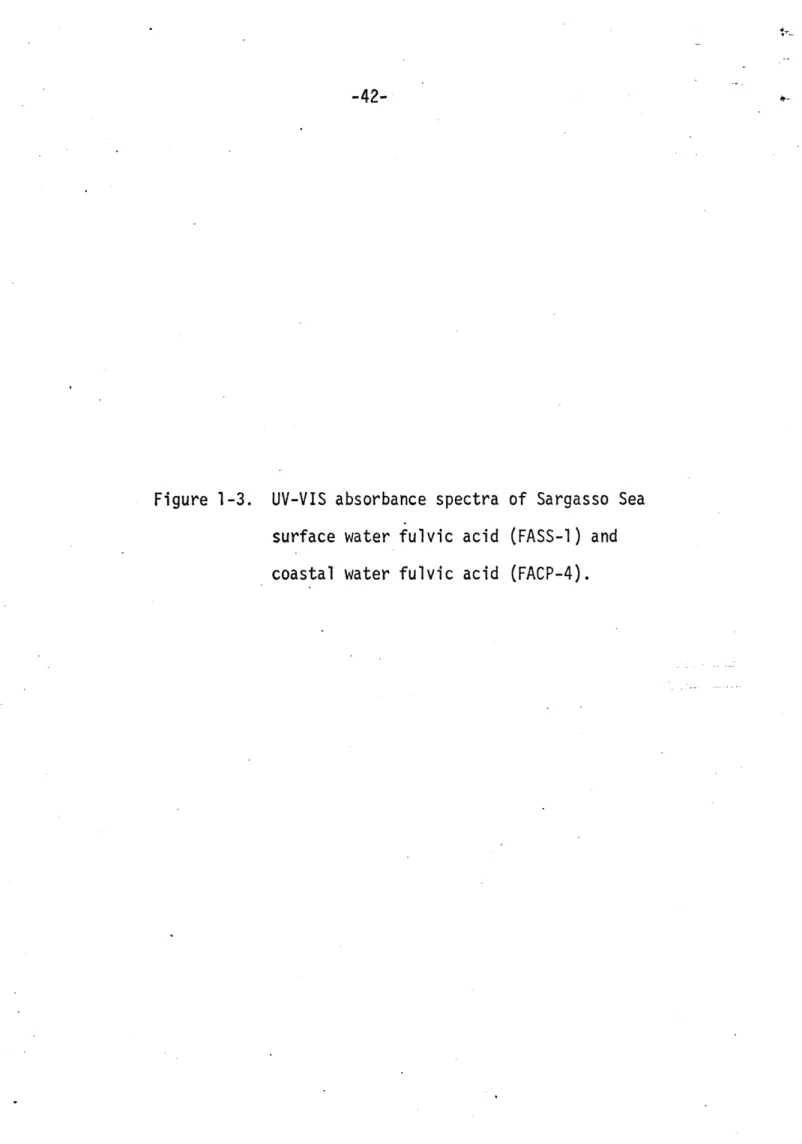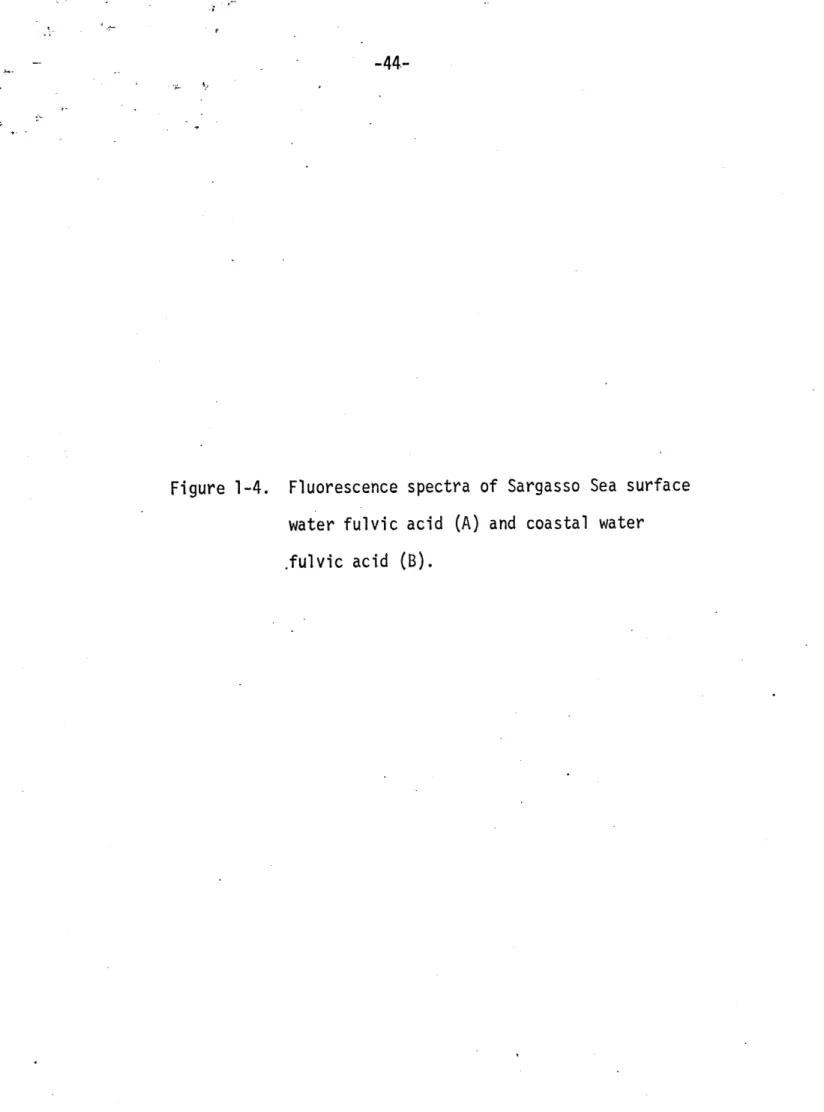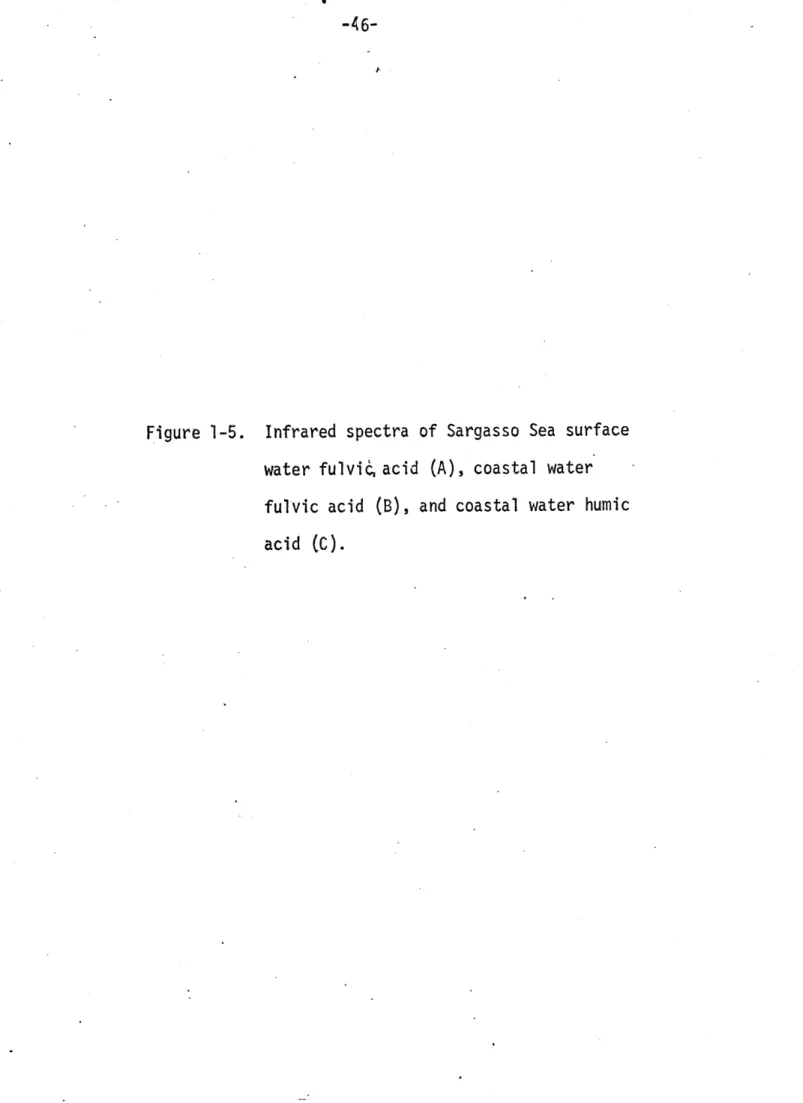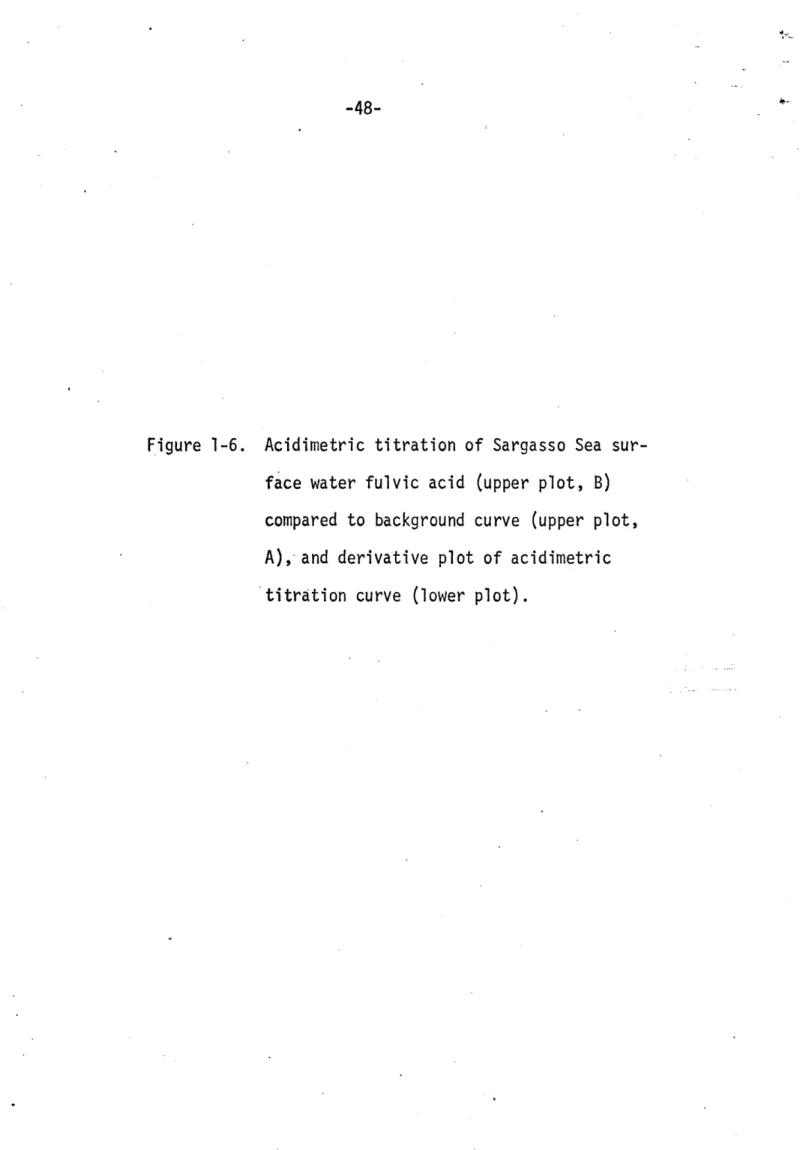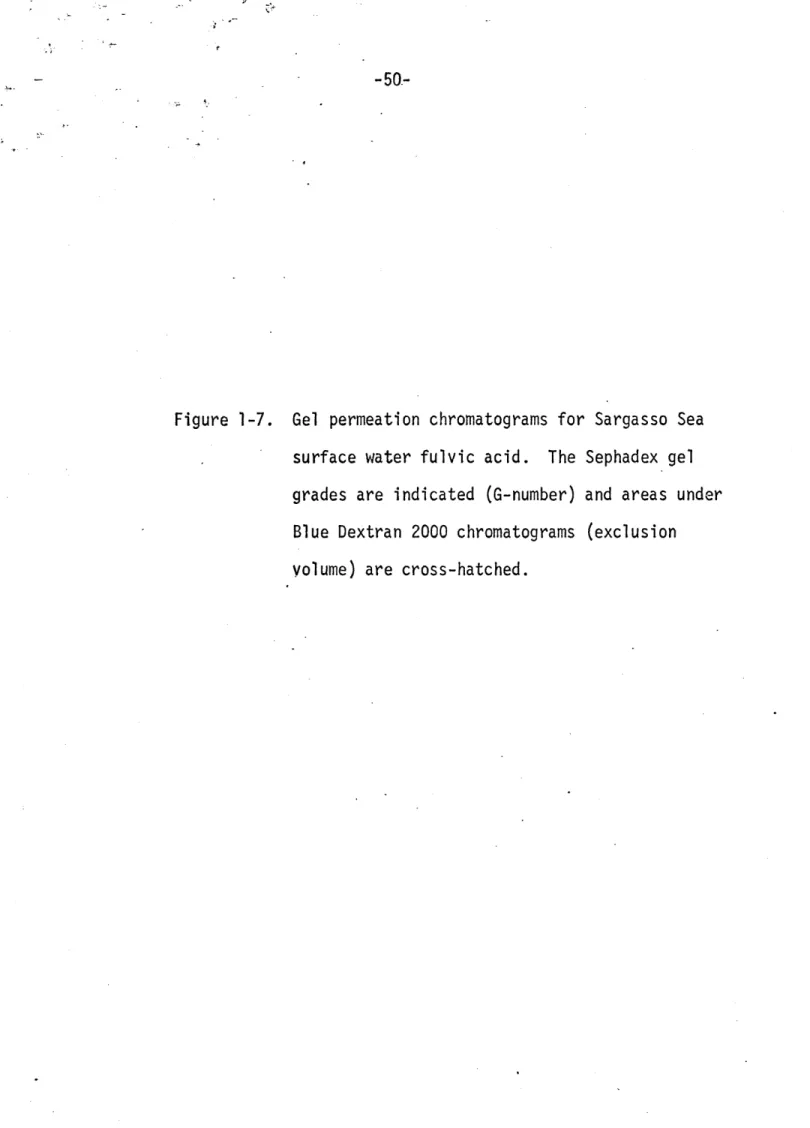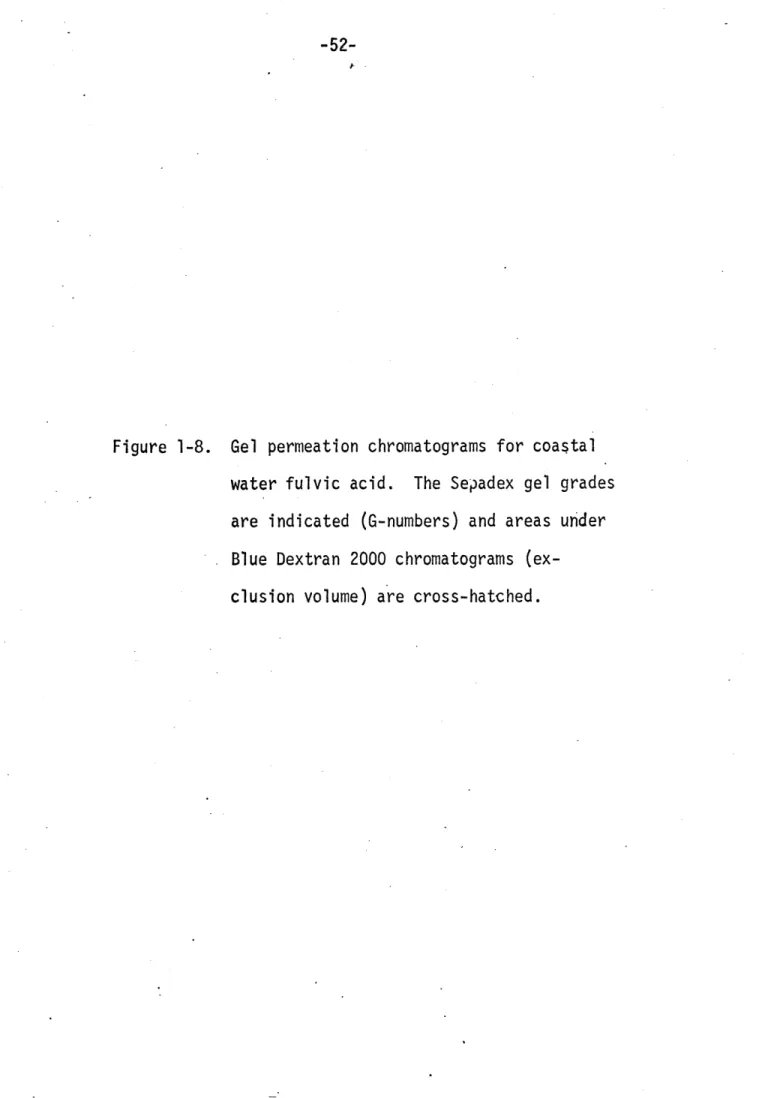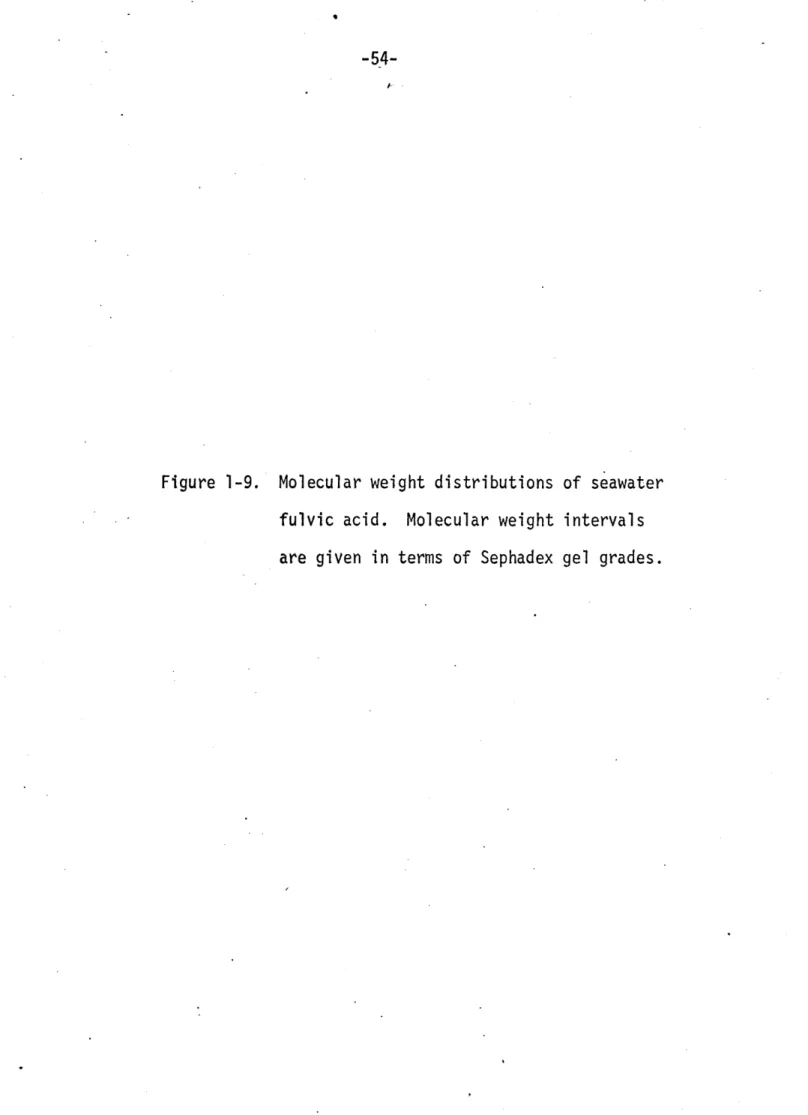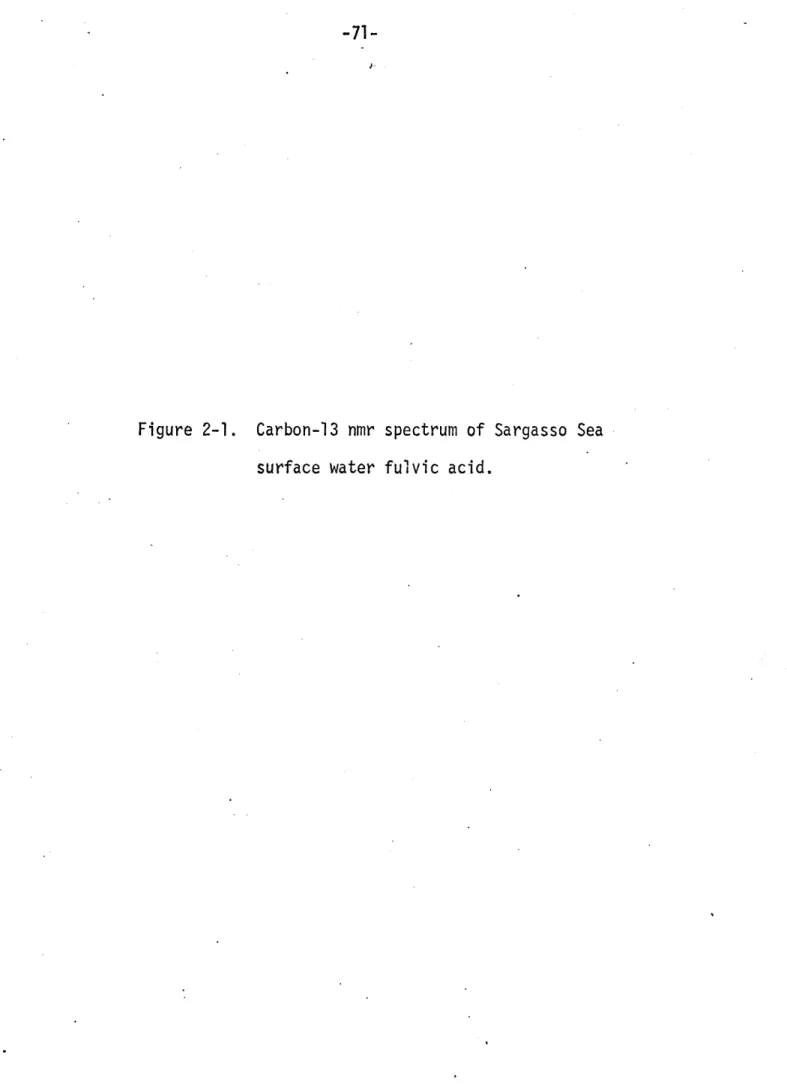THE CHARACTERIZATION OF HUMIC SUBSTANCES IN SEAWATER
by
DANIEL H. STUERMER
B. A., University of California 1970
SUBMITTED IN PARTIAL FULFILLMENT OF THE REQUIREMENTS FOR THE
DEGREE OF DOCTOR OF PHILOSOPHY
at the
MASSACHUSETTS INSTITUTE OF TECHNOLOGY and the
WOODS HOLE OCEANOGRAPHIC INSTITUTION September, 1975
Signature of Author
Joint Program in Oceanography, Massachusetts Institute of Technology-Woods Hole Oceanographic Institution, and Department of Earth and Plane-tary Sciences, Massachusetts Institute of Tech-nology,
pune, 1975.
' 12Certified by
Thois Supervisor Accepted by
Chairman, Joint Oceanography Committee on Earth Sciences, Massachusetts Institute of Technology-Woods Hole Oceanographic Institution.
nI
L
Ren
MITLibraries
Document Services Room 14-0551 77 Massachusetts Avenue Cambridge, MA 02139 Ph: 617.253.5668 Fax: 617.253.1690 Email: docs@mit.edu http://Iibraries.mit.edu/docsDISCLAIMER OF QUALITY
Due to the condition of the original material, there are unavoidable flaws in this reproduction. We have made every effort possible to
provide you with the best copy available. If you are dissatisfied with this product and find it unusable, please contact Document Services as
soon as possible. Thank you.
Due to the poor quality of the original document, there is some spotting or background shading in this document.
-2-THE CHARACTERIZATION OF HUMIC SUBSTANCES
IN SEAWATER by
DANIEL R. STUERMER
Submitted to the Joint Oceanographic Committee of the Depart-ment of Earth and Planetary Sciences, Massachusetts Institute
of Technology, and the Woods Hole Oceanographic Institution on June 2, 1975, in partial fulfillment of the requirements for the degree of Doctor of Philosophy.
ABSTRACT
Humic substances were isolated in gram quantities from seawater by a newly developed procedure of adsorption on a crosslinked polystyrene-divinylbenzene
resin. The chemical and physical characteristics of both humic acid and fulvic acid fractions were studied.
The elemental composition, the acidimetric titration characteristics, the
13C:12C ratios, and the ultraviolet-visible, fluorescence, and infrared spectra
were determined. Molecular weight distributions of coastal and Sargasso Sea fulvic acids were measured by gel permeation chromatography. Structural
fea-tures were further invEstigated by both proton and carbon-13 nuclear magnetic resonance spectroscopy. In addition, the fulvic acids and their derivatives
were analyzed by low and high resolution mass spectrometry and combined gas chromatography-mass spectrometry (GC-MS). Amino acids and organic solvent-soluble products in acid hydrolyzates were investigated. An array of biogenic hydrocarbons produced from fulvic acid by a new reduction scheme were character-ized by GC-MS.
The structural features of seawater humic substances are complex. They are
highly aliphatic, polyfunctional materials containing both polar and nonpolar
moieties. Hydrolyzable amino acids constitute a low percentage of the nitrogen. Fatty acids and other lipids are important structural components. Seawater humic substances have significant structural differences from those of terrestrial origin; this seems to result mainly from the relatively low input of lignin to the marine environment and the differences between the physical environment of the soil and the sea.
A mechanism is proposed for the formation of seawater humic substances from
amino acids, sugars and lipids. The effects and fate of humic substances in the sea are discussed.
Thesis Supervisor: George R. Harvey Associate Scientist
Department of Chemistry Woods Hole Oceanographic
'4
-3-To Betty and
-4-ACKNOWLEDGEMENTS
I am most grateful to Dr. George. R. Harvey for his encouragement,
fruitful advice and friendship. I am also deeply indebted to both
Dr. Robert B. Gagosian and Dr, Max Blumer for valuable help and constructive criticism throughout this work and to Dr. John Ross for his service on my Thesis Committee.
.Laboratory space was generously provided by Dr. Gagosian and
Dr. John W. Farrington. AlsojI would like to extend my thanks to Dr. Brian
D. Andresen, Dr. Nelson M. Frew and Edith H. Ross for their assistance in obtaining mass spectroscopic data:
Dr. James R. Payne was in large part responsible for collection and interpretation of the 13C nmr data for which I am grateful.
Finally, I am pleased to acknowledge Christine Johnson for her assistance in preparation of the manuscript.
ThIs research has been graciously supported by the National Science Foundation (Doctoral Dissertation Grant GA-36631) and by Graduate Fellowships provided by the Arthur Vining Davis Foundations and the Woods Hole Oceano-graphic Institution.
*TABLE OF CONTENTS Page Number TITLE PAGE ABSTRACT 2 DEDICATION 3 ACKNOWLEDGEMENTS 4 TABLE OF CONTENTS 5 LIST OF FIGURES 6 LIST OF TABLES 8 INTRODUCTION g
CHAPTER 1 -- Isolation and Bulk.Propertie. 17
CHAPTER 2 - NMR Studies 56
CHAPTER 3 Chemical Investigations 81
CHAPTER 4 - Conclusions 147
REFERENCES 169
1~ Figure 1-1 1-3 1-4 1-5 1-6 1-7 1-8 1-9 2-1 2-2 2-3 2-4 2-5 3-1 3-2 3-3 3-4 3-5 3-6 3-7 3-8 3-9 -6-LIST OF FIGURES Page Number
Fractionation of humic substances 38
Sargasso Sea sampling stations 40
UV-VIS spectra of seawater fulvic acids 42
Fluorescence spectra of seawater fulvic acids 44
Infrared spectra of seawater humic substances 46
Acidimetric titration of seawater fulvic acid 48
Gel permeation chromatograms of Sargasso Sea fulvic acid 50 Gel permeation chromatograms of coastal water fulvic acid 52
Molecular weight, distribution of seawater fulvic acids 54
Carbpn-13 nmr spectrum of Sargasso Sea fulvic acid 71
Carbon-13 nmr spectrum of terrestrial fulvic acid 73
Proton nmr spectrum of Sargasso Sea fulvic acid 75
Proton nmr spectrum of methylated Sargasso Sea fulvic acid 77 Infrared spectra of methylated Sargasso Sea fulvic acid 79
Fractionation scheme for acid hydrolyzates 107
Reduction scheme for fulvic acids 109
High and low resolution mass spectra of seawater fulvic acid Ill Reconstructed GC of derivatized Sargasso Sea fulvic acid 113 Mass spectrum from GC-MS of Sargasso Sea fulvic acid 115
TLC of methylated Sargasso Sea fulvic acid 117
Mass spectra of TLC fractions 119
Gas chromatograms of amino acids in hydrolyzate 121
Reconstructed GC of amino acids in hydrolyzate 123
---*4
-7-List of Figures (Cont.) Figure
Hypothetical Hypothetical 4-3 Hypothetical
structure of seawater humic substances structure with components indicated structures of soil humic substances
3-10 3-11 3-12 3-13 3-14 3-15 3-16 3-17 3-18 3-19 3-20 Page Number Mass spectrum of organic-soluble acids in hydrolyzate 125
Infrared spectrum'of Sargasso fulvic acid reduction 127
products
GC of fraction 1 of Sargasso fulvic acid reduction 129
products
GC-MS of fraction 1 of Sargasso fulvic acid reduction 131
products
Mass spectra of c-methylalkyl benzenes in reduction 133
products
Mass spectra of a-ethylalkyl benzenes in reduction 135
products
Mass spectra of a-propylalkyl benzenes in reduction 137
products
Mass spectra of ac-butylalkyl benzenes in reduction 139
products
GC-MS of fraction I of coastal fulvic acid reduction 141
products
Gas chromatograms of fraction 5 of fulvic acid reduction 143 products
Histograms of n-alkanes in seawater fulvic acid reduction145 products and normal fatty acids in soil fulvic acid
4-1 4-2
163 165 167
-8-LIST OF TABLES Tahle. 1-2 1-3 1-4 1-5 1-6 2-1 2-2 2-3 3-1 3-2 4-1 4-2 Page Number 19 24 26 27 29 37 58 62 70 86 91 148 149 Sargasso Sea station data
Recovery of humic substances from seawater
UV-VIS extinction coefficients
Fluorescence of seawater fulvic acid
Elemental composition of Sargasso Sea fulvic acid Properties of seawater humic substances
Sargasso Sea station data
Elemental composition of seawater and terrestrial
fulvic acid
-Summary of results - Chapter 2
GC conditions for hydrolysis products
Results of amino acid analysis
Characteristics of seawater humic substances Summary of differences between lacustrine or marine and terrestrial humic substances
-9-INTRODUCTION
The sea is- the second largest- reservoir of organic carbon on Earth after the sediments. It contains.approximately 800 billion tons; 2% of this is present as living organisms, 9% as particulate detritus and 89% as dissolved organic matter (Horne, 1969). The source of almost all the organic carbon in seawater is marine organisms with small inputs from terrestrial runoff and rain (Menzel, 1974) and possibly abiotic synthesis (Fripiat et al., 1972; Harvey et al., 1972). Simple organic compounds are transformed in seawater into complex materials referred to as aqueous humus (Skopintsev, 1972;
Fotiyer, 1972) or Gelbstoff (Kalle, 1966). Organic materials which reach the sediments are subject to further chemical reactions. However, the reactions in seawater and surface sediments, the kinetics and the products of the
transformations are only poorly understood.
The organic compounds in seawater have effects on biological, physical and geochemical processes in the sea. For example, primary productivity is influenced by the presence of dissolved organic carbon (Barber and Ryther,
1969; Sunda, 1975; Prakash and Rashid, 1968) and organic carbon may be an
important source of energy for organisms living in deep waters (Craig, 1970 Wangersky, 1972). Organic matter in seawater modifies the air-sea interface. It is responsible for sea slicks, the foaming of seawater (Blanchard, 1964; Garrett, 1972), and the damping of capillary waves (Garrett, 1967 Barger et al., 1974). Organic compounds participate in processes at the sediment-water interface. Ion exchange (Rashid, 1969), calcite precipitation (Kitano and Hood, 1964; Chave and Suess, 1970) and the surface charge on particles
(Neihoff and Loeb, 1974) may be influenced by the organic matter in seawater. The oxidation of organic matter affects the redox potential of seawater which, in turn, can have dramatic effects on biological and chemical pro-cesses (Breck, 1974). Under special conditions of limited circulation,
com-plete utilization of oxygen can result in reducing environments such as the Cariaco Trench and Santa Barbara Basin.
In spite of the importance of organic carbon in seawater, little is known about how this material influences biological, physical and other
chemical processes in the sea, what reactions occur during the initial stages of transformation and what products result from these transformations. About
10% by weight of the dissolved organic matter in seawater has been identified
as common components of living organisms such as free and combined amino acids, carbohydrates, fatty acids, hydrocarbons, steroids, urea and glycolic
acid (Wagner, 1969; Riley and Chester, 1971; Gagosian, 1975). Structural features and physical properties of the complex material referred to as aqueous humus or Gelbstoff are almost completely unknown.
Bulk Properties Resistance
The resistance of seawater organic matter to bacterial degradation has been investigated by several workers (Kriss, 1963; Barber, 1968; Ogura, 1970; Ogura, 1972; Skopintsev, 1972). The results demonstrate that a frac-tion of the surface water organic matter and nearly all of the deep water organic matter is resistant to bacterial decomposition.
Isotope Ratios
Measurements of1C:1C ratios of the dissolved and particulate organic matter in seawater (Williams, 1968; Williams and Gordon, 1970; Nissenbaum, 1974) demonstrate that1C is enriched during the formation of these materials from the organic matter of primary producers. The preserva-tion of the lighter lipid fracpreserva-tion (Nissenbaum, 1974) relative to the more
labile protein and carbohydrate fractions may be responsible. Spectra
Investigations of the ultraviolet (uv) and visible (vis) absorption and fluorescence of surface seawater have been carried out by Kalle (1938,
1949, 1956, 1961, 1963, 1966), Jerlov (1955, 1968), and others (Armstrong and
Boalch, 1961; Ogura and Hanya, 1952). These authors have shown that seawater displays a smoothly increasing absorption of visible and ultraviolet light with decreasing wavelength and displays a blue fluorescence upon irradiation with ultraviolet light. -Both the absorption and the fluorescence decrease
as the salinity of the seawater sample increases, but the fluorescence to absorption ratio increases. Without more detailed knowledge of the seawater organic matter composition, specific interpretation of these results is not feasible.
Kalle (1966) has observed that the ratio of absorbance at 420 nm to that at 665 nm increase as the salinity of the seawater increases. The value and increasing trend of this ratio with salinity has been interpreted
-12-Gelbstoff are produced in seawater and have structural features similar to melanoidins formed as condensation products of amino acids and sugars. This
interpretation is extremely speculative considering the lack of any support-ing evidence.
Observations by Jerlov (1968) of high uv-vis absorbance in highly
productive upwelling waters west of South America provide evidence that light absorbing substances are produced in seawater. In support of-these findings are results of laboratory studies which demonstrate that light ab-sorbing substances are produced in water of cultures of marine algae (Fogg and Boalch, 1958; Craigie and McLachlan, 1964; Yentsch and Reichert, 1961; Sieburth and Jensen, 1969; Rashid and Prakash, 1972).
Studies of Aqueous Humus
Several investigators have attempted to characterize fractions of the dissolved organic carbon isolated from seawater (Khaylov, 1968; Sieburth and Jensen, 1968; Kerr and Quinn, 1975). Khaylov (1968) isolated a fraction of coastal seawater organic matter by adsorption at the interface of sea-water-chloroform emulsions. This material was base soluble and gel permea-tion chromatography demonstrated that its molecular weight extended to
200,000. From these results, Khaylov (1968) speculated that the material he isolated was proteinaceous in character.
Sieburth and Jensen (1968) isolated a fraction of the dissolved organic carbon from acidified coastal water collected 6 km west of Trondheim, Norw~ay
by absorption on nylon cloth. Analysis of basic eluents by two-dimensional
-13-investigators to assign a phenolic nature to the isolated organic matter. Materials isolated from river water by the same procedure showed different chromatographic patterns, suggesting that the source of the organic matter isolated from seawater was not river runoff.
Kerr and Quinn (1975) have isolated,by adsorption on charcoal,a frac-tion of the dissolved organic matter from coastal and Sargasso Sea surface waters. Ultraviolet and visible spectra of base eluents exhibited absor-bance that increased smoothly towards shorter wavelength. The extinction of comparable base extracts of soil and bay sediments was higher than that of the Sargasso Sea sample. Therefore, the base soluble material isolated
from seawater possesses fewer chromophores than comparable soil or sediment extracts. This indicates a less condensed character for the seawater base-soluble materials.
These investigations leave many gaps in our understanding of the origin, structure and properties of aqueous humus. For example, what fractions of the biologically produced organic matter are incorporated into the aqueous humus, how are these substances involved in biological, chemical and physical processes in the sea, and what fractions of the organic matter are ultimately incorporated into the sediments?
From the studies of Khaylov (1968), Sieburth and Jensen (1968), Jeffrey and Hood (1958) and Kerr and Quinn (1975) it is known that at least 30% of the uncharacterized organic matter in seawater is soluble in aqueous base. Base soluble organic materials are also important constituents of soils and
-
-14--Soil and Sedimentary Humic Substances
Base soluble materials isolated from soils and sediments are defined as humic substances and have been studied extensively. (Soils: Stevenson and Butler, 1969; Kononova, 1966; Schnitzer and Khan, 1972; Sediments: Wakesman, 1933; Rashid and King, 1971, Ishiwatari, 1971; Nissenbaum and Kaplan, 1972; Bordovsky, 1965; Degens et al., 1964; Jackson, 1975.) Humic substances constitute the largest fraction of the organic matter in soils and modern sediments. They are thought to arise from plant and animal
material by decomposition and resynthesis; both bacterial and non-biological processes may be involved. They 4re complex mixtures of variable molecular weight, oxygenated, polyfunctional molecules containing heteroatoms and metals, and phenolic, carboxylic, keto, amido, hydroxylic and quinoid functionality. Specific structural features are not well understood.
Soil and sedimentary humic substances show differences in elemental composition, specific density, functional groups, and products produced upon oxidative or reductive degradation which suggest differences in
struc-ture and a more aromatic character for the soil humic substances (Ishiwatari,
1971; Nissenbaum and Kaplan, 1972; Huc and Durand, 1974; Rashid and King,
1970; Ishiwatari, 1969). These investigations have demonstrated that humic
substances are produced by decomposition and resynthesis in both soils and sediments, however, differences in the sources of organic matter and
the properties of the environment influence the structural features of the final products.
-15-Humic substances of soils and sediments are growth promoting agents for marine algae (Prakash and Rashid, 1968; Prakash et al., 1973) and terrestrial
plants (Schnitzer and Poapst, 1967), chelators of metals (Koshy and Ganguly, 1969; Manning and Ramamoorthy, 1973; Martin et al., 1971; Rashid and Leonard,
1973), and solubilizing agents for hydrophobic substances in aqueous solution
(Matsuda and Schnitzer, 1971; Boehm and Quinn, 1973). Humic substances may be precursors of kerogen in sediments (Degens et al., 1964; Brown et al., 1972; Huc and Durand, 1974).
This Investigation
The basic structural features of the large uncharacterized fraction of seawater dissolved organic matter must be elucidated if we are to understand its sources, mechanisms of formation and effects in the sea. This investiga-tion concerns the characterizainvestiga-tion of a base soluble (humic substance) frac-tion of this material since it has been shown to constitute as much as 30% of the total.
The recovery of sufficient material to allow physical- and chemical characterization studies was required. An isolation procedure was developed to obtain gram quantities of humic substances from seawater containing fractions of milligrams per liter in the presence of 35 grams per liter of salt. Humic substances were isolated from seawater well away from the in-fluence of terrestrial runoff so that results of characterization represent humic substances of truly marine origin. Characterization included basic physical property analyses, as well as chemical analyses designed to provide
-16-structural information. The results are compared to studies of humic sub-stances from soils and sediments to aid in interpretation. The results are interpreted so as to provide information on structural features,
possible precursors and mechanisms of formation of the humic substances in seawater.
-17-CHAPTER 1 Introduction
This chapter describes the procedure developed for the isolation of humic substances from seawater, the fractionation of the humic substances into humic acid (HA) and fulvic acid (FA) and analyses of bulk properties of these materials. Humic acids are operationally defined as organic materials which are soluble in aqueous base and insoluble in aqueous acid. Fulvic
acids are soluble in both aqueous base and aqueous acid (Figure 1-1). Acid-base fractionation methods were developed by soil chemists to obtain more homogeneous subfractions of soil organic matter (Schnitzer and Khan, 1972); it is employed in this study for the same purpose.
The HA and FA were studied by ultraviolet (uv), visible (vis), fluores-cence, and infrared (ir) spectroscopy, and their molecular weight distribution, elemental composition and 13C/12C ratios were determined. The equivalent
weight of Sargasso Sea FA was determined by acidimetric titration. These data and comparison with data on soil and sedimentary humic substances, which have been more extensively studied, provided structural information on seawater
humic substances.
The results presented in this chapter provide the background for the more extensive chemical investigations in Chapters 2 and 3.
Experimental
Northwestern Sargasso Sea surface and deep water samples were collected in
-18-Table 1-1). Coastal water samples were collected from a pier in three meters of water in Vineyard Sound, Massachusetts, U.S.A.
Surface seawater (6 m) was sampled by drawing water with vacuum through a 3/4 inch # 316 stainless steel pipe extended over the side of the ship and was collected in 55 gallon, # 316 stainless steel drums. Water samples contacted
only stainless steel. The ship's sewer and garbage disposal were secured before arriving and while on station. The deep (1500 m) water sample (360 1) was
collected by six successive lowerings of a 60 liter Bodman bottle (Bodman et al., 1961) and transferred to the 55 gallon drum.
All sampling equipment was cleaned prior to use with hot alkali, and
successive washings of Micro detergent (International Products, Trenton, N. J.), water, 1. N HC, 1 N NaOH, ethanol and distilled water. A final 1% NH4OH rinse
was checked by uv spectroscopy and showed no uv absorption higher than a re-ference solution. Prior to use, the sampling equipment was rinsed with sea-water.
Isolation and Fractionation of Humic Substances
The seawater samples were acidified to pH 2 with 12 N HCl and passed through a 250 cc column (height:diameter = 10:1) of Amberlite XAD-2 resin
(Rohm and Haas, Philadelphia, Pa.) (Rohm and Haas, 1972; Riley and Taylor,
1969) with glass wool plugs above and below to secure it and to prevent large
particles from entering. Flow rates were less than two bed volumes per minute.
After use, the resin was frozen for storage and thawed before elution. The resin was then placed in a new column and salt was eluted with distilled
-19-TABLE~1-1
Sargasso Sea Station Data
Station Location
R/V CHAIN-ill Temperature (0C) Salinity (0/00)
39044.0'N, 64035.0'W 37032.8'N, 62052.1'W 35023.4'N, 60003.0'W
R/V KNORR-33 (Surface Water) 35013.8'N, 63035.9'W 33039.0'N, 62020.4'W 32023.0'N; 59050.0'W 32018.5'N, 62059.4'W (1500 m) 32028.0'N, 59048.0'W 17.7 22.1 19.1 36.730 36.618 36.735 27.1 27.1 27.4 27.8 36.006 36.330 36.591 36.258 4.5 35.092
-20-water to -a negative silver nitrate test; no color was observed in this eluent. The humic substances were then eluted with 5 bed volumes of NH40H solution
prepared fresh to pH 11.6 by dissolving reagent grade ammonia gas in
KMnO
4distilled water. The eluent was concentrated at 350C to 25 ml on a rotary
evaporator, acidified to pH 2, and extracted with methylene chloride to remove lipids. The humic substances were recovered from the aqueous solution by lyophilization. The fulvic acid fraction was obtained by dissolution in 0.01 N HCl; the insoluble humic acid was removed by centrifugation at 1800 g for
15 minutes. The humic acid was dissolved in NH4OH, lyophilized to remove
ex-cess ammonia, and suspended in 0.01 N HC. Lyophilization of the two frac-tions yielded the dry fulvic and humic acids in the protonated form.
The adsorption efficiency of the resin for fulvic acid was estimated by readsorption of the fulvic acid from 0.7 M NaCl (approximate seawater ionic strength) solution at pH 2 on an Amberlite XAD-2 column. Measurement of the uv absorbance of the solution entering and leaving the column at different flow rates was used to determine adsorption efficiencies. Efficiencies greater than 97% were observed at flow rates below 2 bed volumes per minute. Recovery from the column by base elution as described above was 73%.
An experiment was carried out to determine if nitrogen was incorporated into the fulvic acid by the NH40H elution procedure. Identical columns were
used to isolate fulvic acid from identical coastal water samples. The first column was eluted with NH40H and the second column was eluted with NaOH of
equal pH and ionic strength. Fulvic acid was recovered from the NH4OH
-21-acid from. the NaOH eluent. The C/N atomic ratios of the NaOH-eluted fulvic acid and NH40H-eluted fulvic acid were 15.1 and 13.4, respectively. The
NH40H elution procedure was adopted in spite of this nitrogen increase to
avoid contamination problems from desalting with ion exchange resins or losses of low molecular weight material while desalting by dialysis.
Preparation of the Resin
Raw Amberlite XAD-2 resin contains many impurities and requires extensive cleaning prior to use. Soxhlet extraction, first with acetonitrile then by
several batches of benzene reduced blanks to nanogram levels within three
weeks. The resin was checked for impurities by elution in a column with both
0.5 N NaOH and ethanol; the eluents were concentrated to 1/100 their volume and
analyzed by uv. Also, the acidified base eluent and the water diluted ethanol
eluent were extracted with hexane, the hexane was concentrated to 10Oyl, and
5pl was analyzed by gas chromatography on a 2% SE-30 column (Chromosorb W HP,
6 ft., temperature programmed, 75 to 3000C at 60C/min). No peaks were observed
with the clean resin eluent extract (detection limit 10 ng/component); the un-treated resin showed a complex distribution of peaks.
During a two week exposure of Amberlite XAD-2 resin to 0.01 N HCl at room temperature in the light less than 5 pg of two compounds were formed.
These compounds were identified (by methylation and GC-MS) as benzoic acid and phthalic acid. It is likely that these are products of oxidation of .the
Amber-lite XAD-2 resin, a styrene-divinylbenzene polymer.
Spectroscopy: UV-VIS absorption spectra were measured in distilled water with a Cary model 14 spectrophotometer.
1/ )
-22-Ir spectra were obtained on a Perkin-Elmer Model 337 grating infrared spectrophotometer.
Fluorescence analyses were carried out on a Perkin Elmer model MPF-3L
fluorescence spectrophotometer. Sample concentrations in distilled water were used such that absorbance was less than 0.05 at the excitation and fluorescence emission wavelengths to avoid non-linearity, quenching and self
absorption. Fluorescence maxima as a function of excitation wavelength were determined by holding the emission monochromator at the fluorescence maximum while scanning the excitation monochromator from 200 to 400 nm. The following
standard conditions were used to make relative measurements: an excitation wavelength of 313 nm was chosen and fluorescence intensity of 1.0 ppm (yg/ml)
sample solutions was compared to that of a 1.0 ppm quinine sulfate (Matheson, Coleman and Bell Chemicals) solution at their fluorescence maxima.
13C/12C Ratios: The s13C values, of the CO
2 gas evolved in burning 1 mg of
solid sample at 8000C over Cu0 was determined with a Nuclide mass spectrometer (State College, Pa.). 613C is defined as:
13
C/
12 Csample- 1 X
1000.
(13C/12c(%/l standard
j
The National Bureau of Standards Norite sample 20 served as the standard but values are reported relative to Chicago Pee Dee Belemnite.
Elemental Analyses: Duplicate analyses for C, H, N, S, and ash were carried out by Galbraith Laboratories, Inc., (Knoxville, Tenn.) on the fulvic acid sample from the Sargasso Sea surface water.
-23-Acid Titration: A titration of fulvic acid isolated from the Sargasso Sea was carried out in carbonate-free NaOH solution with standardized HCl
(0.0975 N). The titration curve of the sample solution is compared to that
of a blank NaOH solution.
Molecular Weight Distributions: The molecular weight distributions were determined by gel permeation chromatography (GPC) on Sephadex G-10, G-15 and
G-25 gels (Pharmacia Fine Chemicals, Inc.). The eluent was 0.05 M NH4HCO3
(pH 7.1). Samples (10 mg) were dissolved in 5 ml of buffer and each
chromato-gram was run on a new sample. Columns were 2.5 cm in diameter and 80 to 100 cm long. The exclusion volume of each column was determined by chromatograph-*ing a 5 ml sample of Blue Dextran 2000 (molecular weight 2,000,000). Sample
elution was monitored with a Gilford in-line absorptiometer (Oberlin, Ohio) at 280 nm. Five milliliter fractions were collected for measurements of ab-sorption spectra.
Total Organic Carbon Analysis: The organic carbon content of unfiltered acidified seawater samples was determined by the method of Menzel and Vaccaro
(1964). Results
Recoveries of humic acid and fulvic acid from the seawater samples, the
HA:FA ratios, the percent of the total organic matter (TOM) represented by
these fractions, and the absolute amounts isolated in Ug/l are presented in Table 1-2.
The uv-vis -absorption of both the coastal and Sargasso Sea fulvic acid
-24-TABLE 1-2
Recovery of Humic Substances from Seawater
Water Volume
(1)
Total (HA +
(mg)
FA) HA: FA
Ratio % of DOC Absolute Re-covery (pg/1)
R/V CHAIN-1ll Surface 1150 R/V KNORR-33 Surface Deep 2000 350 Pier - Vineyard Sound
200 122.7 16:84 Sample 153.6 0:100 5.1 134 287.2 66.2 April, 1973 3:97 22:78 4.9 22.5 144 189 35.7 15:85 4.5 179 June,'1973 600 3.7 205
-25-;'t 280 nm in the Sargasso sample (Figurel-3). The ratio of absorbance at 420 nm to that at 665 nm (E 420/665) is lower for the Sargasso Sea fulvic acid than for the coastal fulvic acid. Light extinction on a unit weight basis is
dramati-cally lower at all wavelengths for the sample from the Sargasso Sea (Table 1-3).
Fluorescence spectra of Sargasso Sea and coastal surface water fulvic
acids are presented in Figure 1-4. A single fluorescence maximum at 405 nm is observed for the Sargasso sample while a primary fluorescence maximum at 415 nm and a secondary maximum at 437 nm is observed for the coastal sample
(Figure 1-4). Single excitation maxima at 332 nm and 325 nm were observed for
the Sargasso and coastal samples, respectively. Higher concentrations of
250 pg/ml were used to eliminate interference of. the water Raman band for
qualitative display in Figurel-4. Sample fluorescence intensity compared to the quinine standard with dilute sample solutions (10 ypg/ml) are presented in
Table 1-4, together with fluorescence intensity relative to absorbance of the
sample at 313 nm and 420 nm.
The ir spectra of Sargasso Sea surface water fulvic acid and coastal
water fulvic and humic acid(Figure 1-5) all display broad absorption in the 0-H and N-H stretching region characteristic of acids, alcohols, amines and amides (2900 to 3600 cm1). The absorption in the C-H stretching region
(2800 to 3100 cm~1) is partially masked by the acid 0-H stretching but still
evident in all spectra. The broad absorption at 1700 cm~1 is due to C=0 stretching of carboxylic acids and other carbonyl groups. Strong absorption is also observed in the C-H bending region (1350 to 1480 cm~1) and C-0, C-N, and C-C stretching region (900 to 1300 cm~1).
-26-- TABLE 1-26--3
UV-VIS Extinction Coefficients (1 g~1 cm~)
Fulvic Acid Sample Wave Length (nm) 240 250 260 270 280 290 300 350 400 420 500 665 Sargasso Sea 4.38 2.30 1.59 1.32 1.04 0.64 0.45 0.40 0.07 0.05 0.03 0.01 CoastalWater 10.75 8.89 7.89 7.29 6.21 5.08 4.29 1.99 0.79 0.50 0.16 0.06 E 420/665: 4.8 8.2
-27-TABLE 1-4
Fluorescence of Seawater Fulvic Acid
Fluorescence Intensity Fulvic Acid Samn c Fluorescence:Absorbance Ratio 313 nm 420 nm Sargasso Sea Coastal Water 1.31 x 10-3 4.82 x 10-3
Fluorescence intensity of 1 ppm sample solution relative to 1 ppm quinine sulfate solution - excitation wavelength 313 nm.
Fluorescence intensity divided by absorbance (1 mg~l cm~f) at wavelength indicated. 3.0 1.3 26.0 9.6 .,FAIIIF 8 %. -
-
-28-The two fulvic acid ir spectra have absorptions at 1560 cm~1 which is absent in the humic acid spectrum (Figure1-5). This band is characteristic of carboxylic acid anions, monosubstituted amides or primary amines.
The 613C values of Sargasso Sea surface water fulvic acid, coastal water
fulvic acid and coastal water humic acid are -22.79 0/oo, -23.72 0/oo and -22.78 o/oo, respectively.
Table 1-5 presents the elementaL compdsiton and atomic ratios of Sargasso Sea surface water fulvic acid along with typical elemental compositional ranges
of soil and marine sedimentary fulvic acids.
No inflections in the titration curve (Figure 1-6) nor secondary maxima in the derivative plot (Figure 1-6) are observed. An equivalent weight of 473
g/eq is calculated from the titration data.
The get perneation chromatograms of Sargasso Sea and coastal water fulvic
acid are presented in Figure l-7 and- 1-8. Also shown are the Blue Dextran 2000 chromatograms (cross-hatched areas) which have been normalized to the sample curves. The molecular weight distributions calculated from the GPC data for the two samples are presented in Figure 1-9. These distributions are
cal-culated from the fraction of the sample excluded from each gel (equivalent to the cross-hatched area) and the fraction of the sample retained by that gel, (equivalentto the remaining area under the curve). The calculation requires the assumption of a constant extinction coefficient over the entire GPC run,
though elution curves at 280 nm and 420 nm give evidence of variations in the relative extinctions during the GPC run. However, molecular weight
distribu-tion calculadistribu-tions using either wavelength agree within 4%. The assumption is expected to bias the results slightly towards higher molecular weight.
-29-TABLE 1-5
Elemental Composition of Sargasso Sea Fulvic Acid (Ash: 3.37%)
%C %H %N %0 %S H/C
49.98 6.76 6.40 36.40
Marine Sedimentary Fulvic Acid (Rashid and King,
0.46
1970)
1.61
41.8-44.3 1.49-1.70
Soil Fulvic Acid (Schnitzer and Khan, 1972) 0.7-2.8 44.8-47.3
46.2-48.7 6.0-6.6 3.4-5.2
-30-Weighing of the small GPC fractions in the presence of large amounts of buffer salt was not feasible.
An uncertainty exists concerning the exclusion limits of the gels; there-fore, molecular weight ranges are given as Sephadex gel grades. Calibration of the Sephadex G-10, G-15 and G-25 gels with proteins and polysaccharides
yields exclusion limits of 700, 1500 and 5000, respectively. However, according to Schnitzer and Skinner (1968) these limits are too high when applied to
soil fulvic acid and, therefore, may be high when applied to seawater humic sub-stances.
All samples are eluted within one column volume and upon rechromatography
of narrow elution fractions, elution again takes place within the same narrow band; this demonstrates that gel-solute interactions are not interfering with molecular size separation.
Discussion
The adsorption procedure developed in this study allows the convenient isolation of gram quantities of dissolved organic matter (DOM) from tons of seawater containing kilograms of salt. Between 4 and 23% of the total organic carbon in seawater is recovered as humic substances depending on the sample origin (Table 1-2). The stability of the divinylbenzene-styrene polymer resin
(Amberlite XAD-2) allows organic blanks to be reduced to levels not attain-able with charcoal or polyamide resins previously used (Sieburth and Jensen,
1968; Kerr and Quinn, 1975). The elution procedure avoids desalting of the final isolates.
Adsorption of humic substances on Amberlite XAD-2 resin is by simple
hydrophobic bonding to the polyaromatic hydrocarbon resin surface. Only
-31-Hydrophilic compounds such as amino acids, sugars, etc. are not adsorbed by the resin (Rohm and Haas, 1972). Humic acids, because of their higher molecular weight and lower oxygen content, are much less water-soluble and more hydro-phobic under acidic conditions than fulvic acids and would be expected to ad-sorb to XAD-2 more efficiently. Fulvic acids containing more hydrophobic moieties would be adsorbed on XAD-2 in preference to more hydrophilic fulvic
acids. Therefore, a low recovery of humic acid (high FA:HA ratio) is' evidence that low levels of humic acids are present in the seawater sampled. On the other hand, low recoveries of fulvic acids may result from either low levels in the seawater or a smaller fraction of fulvic acids containing sufficient hydrophobic character for adsorption.
In spite of the limited number of samples, it is interesting to specu-late on variations in recoveries of humic substances and on the FA:HA ratios observed in different samples.
The highest. (97:3) and lowest (78:22) FA:HA ratios are observed in the Sargasso Sea surface and deep water respectively, although the absolute re-coveries in pg/l are similar (Table 1-21. These observations suggest that the
transformation of fulvic acid to humic acid is occurring over time since the deep water contains organic matter which is older than surface water organic matter (Williams et al., 1969). The transformation of fulvic acid to humic acid in soils and sediments is suggested by several studies (Kobo and
Tatsukawa, 1961; Nissenbaum and Schallinger, 1974; Nissenbaum, 1974).
The small humic substance fraction of the TOC (Table 1-2) in the Sargasso Sea surface water sample C5%) compared to that of deep water (23%) may be
-32-the result of a large fraction of hydrophilic, non-humic substances freshly
produced by biological productivity in the surface waters.
In coastal water samples, the low humic substance fraction of the TOC may also indicate that a large fraction of the TOC is present as hydrophilic
and non-humic organic substances produced by biological productivity. In addition, adsorption and subsequent deposition of the more hydrophobic dis-solved materials with the high particulate load in coastal waters will leave
less dissolved material in solution which can be adsorbed by the Amberlite XAD-2 resin. The relatively low FA:HA ratio (85:15) in coastal water compared
to the Sargasso Sea surface water sample, may result from the short water
column in which humic acid fluxes from bottom sediments or bacterial or surface catalyzed conversion of FA to HA on the more abundant particulate
matter can affect the dissolved humic substance composition. Terrestrial runoff does not seem to contribute since the 613C values of the coastal water humic substances (-22.7 to -23.8 0/oo) are within the range of 613C values of marine sedimentary humic substances (Nissenbaum and Kaplan, 1972),
dis-solved organic matter in open ocean seawater (Williams, 1968), and very close
to the value obtained for the Sargasso sea surface water fulvic acid (-22.8 0/00). Terrestrial humic substances typically have 613C values- between -25 and -29 0/00
(Nissenbaum and Kaplan, 1972).
The elemental composition of the Sargasso Sea surface water fulvic acid is compared to that of fulvic acids isolated from soil and marine sediments in Tablel-3. The oxygen content is low and the H:C atomic ratio is high. The
-33-fulvic acids from marine sediments. The nitrogen content is within the range of marine sedimentary fulvic acids but much higher than that reported for soil fulvic.acids, The small ammonia uptake during isolation of the fulvic acid does not affect this interpretation.
The low oxygen content and high :C ratio suggests fewer functional groups and less unsaturation in the seawater fulvic acid. This is supported by
the lower light absorbance, especially in the visible range (Table 1-3; Figure
1-3), when compared to that of soil and sedimentary fulvic acid.
The low sulfur content observed for the fulvic acids from seawater and soil may reflect the low abundance of organic sulfur in plant and animal material, while the high sulfur values observed in marine sedimentary fulvic
acid may result from diagenetic processes-in reducing sediments (Nissenbaum and Kaplan, 1972).
High nitrogen functionality indicated by the abundant nitrogen in the
seawater fulvic acid is supported by the ir absorption at 1560 cm~1 characteristic of secondary amides, amines or carboxylate anions (Figure 1-5). Absorption in this region is not observed in soil fulvic acid ir spectra but is prominent in ir spectra of lacustrine sedimentary humic substances (Ishiwatari, 1967).
Ishiwatari observed a correlation between the absorbance at 1540 cm~ and the nitrogen content presumably in amide functions of humic substances. However, carboxylate anions in amphoteric species also absorb in this region; their
abundance would depend on the presence of amino cations and, therefore, nitrogen content. The 1560 cm~1 absorption in the fulvic acid spectra and its absence in the humic acid spectrum (Figure 1-5) supports that explanation since solu-bility in acid would be enhanced by the amphoteric property.
-34-Except for the 1560 cm~ absorption discussed above, the ir spectra of seawater humic substances show characteristics similar to those of soil and sedimentary humic substances. Complex and broad absorption bands suggest complex mixtures of polyfunctional organic molecules.
Complex mixtures of functional groups is also indicated by the lack of inflections on the main titration curve and lack of secondary maxima on the
derivative plot (Figure 1-6) of seawater fulvic acid. The wide range of pKa
values may indicate polyacidic (Stumm and Morgan, 1970, p. 482) or mixtures of amphoteric structures. In contrast, soil humic substances display inflec-tions on the titration curve which become more prominent in derivative plots
(Borggaard, 1974); discrete groupings of. pKa's characteristic of carboxylic
acid and phenolic functionality are indicated.
The equivalent weight of 473 g/eq determined for the Sargasso Sea surface
water fulvic acid and high oxygen content (approximately 10 oxygens/eq; Table
1-5) indicate that most of the oxygen in the fulvic acid is present as
non-acidic functional groups such as alcohols, ethers, amides and esters. The 613C values of the seawater humic substances (-22.7 to -23.8 0/00)
fall within those of humic substances isolated from marine sediments
(Nissenbaum and Kaplan, 1972) and those of seawater dissolved and particulate organic carbon (Williams, 1968; Williams and Gordon, 1970). Continental humic substances have 6C13 values between -25 and -29 0/oo (Nissenbaum and Kaplan,
1972). This supports the assumption of marine sources for the seawater humic
-35-Most of the fulvic acid isolated 'from the Sargasso Sea has a molecular weight less than 700, with none extending above 5,000 (Figure 1-8). The coastal water fulvic acid molecular weight distribution is only slightly higher. In contrast, soil fulvic acid has molecular weights extending to 10,000 (using the same criteria) (Schnitzer and Skinner, 1968) or higher (Kononova, 1966).
Sedimentary humic substances have molecular weights extending to 2,000,000 (Rashid and King, 1969).
Condensation reactions are less likely to occur in the dilute solution of seawater than in sediments or soils where organic matter is concentrated on particle surfaces. The lower molecular weight range observed for seawater fulvic acid may result from fewer condensation reactions in the extremely dilute solution existing in the sea.
From the uv-vis and fluorescence measurements, it is apparent that the uv-vis absorption and fluorescence intensity of the Sargasso Sea fulvic acid is less than that of the coastal fulvic acid. However, the fluorescence intensity: uv-vis absorbance ratio is higher for the Sargasso fulvic acid. These same
general features have been observed for absorbance and fluorescence of total seawater by Kalle (1966) and, although quantitative comparison is not possible, the data suggests that the fulvic acid fraction of the TOC is partially
responsible for Kalle's observations.
Low E 420/665 values and high light absorption have been used to indicate a high degree of condensation of humic substances (Nissenbaum and Kaplan, 1972; Kalle, 1966). However, for seawater humic substances both low light absorbance and low E 420/665 ratios are observed (this work; Kerr and Quinn, 1975)
-36-Kalle (1966) has observed that open ocean seawater has a higher E 420/665 value than coastal seawater. However, humic substances from the Sargasso Sea have a lower E 420/665 than humic substances of coastal water (this work;
Kerr and Quinn, 1975).. This indicates that other fractions of the TOC are responsible for this observation of Kalle's.
Summary
(1) A method was developed for isolating gram quantities of dissolved
organic matter from seawater for chemical and physical analyses.
(2) The bulk properties of seawater fulvic and humic acid are summarized in Table 1-6.
(3) The marine origin of seawater humic substances is indicated by
significant differences in compositional and spectroscopic characteristics from those of terrestrial humic substances.
(4) The low molecular weight range of seawater fulvic acid seems to result from the dilute solution in seawater which decreases the rate of intermolecular reactions.
(5) Differences between seawater and terrestrial humic substances are
most likely the result of differences in sources of organic matter from which the humic substances are formed.
-37-TABLE 1-6
Properties of Seawater Humic Substances
Elemental Composition: Sargasso Sea fulvic acid
UV-VIS Spectrum:
Fluorescence Spectra:
IR Spectrum:
613C (PDB)
Acid Titration:
Sargasso Sea fulvic acid M. W. Distribution:
a) C: 49.98; H: 6.40; 0: 36.40; S: 0.46
b) H/C = 1.61
c Stoichiometric formula: C9H1505N
a) Smoothly increasing absorption with
de-creasing wavelength
b) E420/665: 8.2 coastal water fulvic acid
4.8 Sargasso Sea fulvic acid c) Extinction of coastal greater than Sargasso
Sea fulvics
a) Excitation maxima:
Sargasso Sea fulvic acid: 332 nm Coastal water fulvic acid: 325 nm
b) Fluorescence maxima:
Sargasso Sea fulvic acid: 405 nm
Coastal water fulvic acid: primary 415 nm secondary 437 nm
c) Fluorescence intensity per unit weight:
Sargasso Sea fulvic acid less than
coastal water fulvic acid
a) Broad absorptions characteristic of complex mixtures
b) Similar to fulvic acids of other
environ-ments -.
c) Absorption at 1560 cm in fulvic acids
-not in humic acid
a Sargasso Sea fulvic acid: -22.790 oo
-b Coastal water fulvic acid: -23.72 /oo
c Coastal water humic acid: -22.780/oo
.a) Smooth curve indicates wide range of pKa's b) Equivalent weight = 473 g/equivalent
a) Coastal water fulvic acid:
55% less than 700
81% less than 1500
99% less than 5000
1% greater than 5000
b) Sargasso Sea fulvic acid:
73% less than 700
84% less than 1500
Humic
Substances-Base Soluble
Organic Insoluble
Treat Basic Solution
With Acid
Insoluble
Soluble
-40-Figure 1-2. Sargasso Sea sampling stations on R/V CHAIN cruise 111 (0), and R/V
KNORR cruise 33 (surface samplea;
70* 650 600
C
0cBermuda c
2
U.S.
450 400 350 300-42-Figure 1-3. UV-VIS absorbance spectra of Sargasso Sea surface water fulvic acid (FASS-1) and coastal water fulvic acid (FACP-4).
FASS-1(190mg 0.5 -) I - I I I I EU )
FACP-4 (140mg
.
250 300 350
400
500
nm
0.c
I.c
C-) C 0 0 (I) -o -I) 0.50.0
x.2 600I.Or-
-44-Figure 1-4. Fluorescence spectra of Sargasso Sea surface water fulvic acid (A) and coastal water .fulvic acid (B).
400 500 600
nm
p 90 80 70 60 50 40 y 30 I-z 20 w z ~ 10 0 z w o 90 U) w cL g80 I 70 60 50 40 30 20 10 0 320 700
-46-Figure 1-5. Infrared spectra of Sargasso Sea surface water fulvi, acid (A), coastal water
fulvic acid (B), and coastal water humic acid (C).
0 R9 !a -. . iI 441 T7--- - -e t 1 t-4 - - - - - I--- T -- . .. . -. -4-IN .b~toSUv, 4T h w +
-41-2<
-I-q--LTi
0-4
Ltt44 'y 4+ t t t -- It p -7 --- f- ---t - -c 44 .. - o 4 -j--- - --- - M--- --C C4 1- T--
-48-Figure 1-6. Acidimetric titration of Sargasso Sea sur-face water fulvic acid (upper plot, B) compared to background curve (upper plot, A), and derivative plot of acidimetric
10 A 9~ B 8- 7-I 6 C. 5- 4-3 -2 160- 140- 120-(0 <0 0100 x >
80-r
60- 40- 20-0 0 50 100 150 200 250 300 350 400 450 500
-50-Figure 1-7. Gel permeation chromatograms for Sargasso Sea surface water fulvic acid. The Sephadex gel grades are indicated (G-number) and areas under
Blue Dextran 2000 chromatograms (exclusion volume) are cross-hatched.
RELATIVE ABSORBANCE p p 0 0 0'n' 0' 280 nm 280nm 280nm N <0 6
-52-Figure 1-8. Gel permeation chromatograms for coastal water fulvic acid. The Sepadex gel grades are indicated (G-numbers) and areas under
Blue Dextran 2000 chromatograms (ex-clusion volume) are cross-hatched.
RELATIVE ABSORBANCE 0 0.00 280nm 280nm 450nm 000 CD< N .) o< -b 'o <0E-5 0 i V. 1~
-54-Figure 1-9. Molecular weight distributions of seawater fulvic acid. Molecular weight intervals are given in terms of Sephadex gel grades.
1.0 -1 Coastal Water
0.8-
0.6-
0.4-
0.2-
0-
0.8-
0.6-70.4
-7
00 (9V
0.2
-LOSargasso Sea
7d
00 ~) ~)yy(D
Molecular
Weight
Range
h I 'It
0
K
I I jr-Ir r .1 201 1.0,
-56-CHAPTER 2 Introduction
This chapter presents carbon-13 (13C) and proton (1H) nuclear magnetic resonance (nmr) spectra, infrared absorption spectra, and elemental composition data on Sargasso Sea surface water fulvic acid. The data are compared to
existing data and 13C nmr spectra obtained on terrestrial fulvic acid and inter-preted to provide structural comparison between terrestrial and seawater fulvic acids.
Carbon-13 nmr has been a useful tool for obtaining structural information on small as well as on complex organic molecules (for reviews: Stothers, 1972; Levy and Nelson, 1972; Gray and Smith, 1973; Payne, 1974). In principle, 13C
nmr is analogous to 1H nmr (Becker, 1969; Emsley et al., 1965; Stothers, 1972;
Levy and Nelson, 1972). Thus the resonance frequencies of 13C nuclei placed in an external magnetic field depend on the strength of the applied magnetic field and on the local magnetic environment of each carbon atom. The advantage
of 3C nmr over H nmr is that every carbon atom can, in principle, be observed
including fully substituted aliphatic, substituted aromatic, carbonyl, acetylenic and nitrile carbons. Furthermore, the chemical shift range of 13C nmr extends
well over 225 ppm compared to the 15 to 20 ppm range typically encountered with H nmr. Another advantage of 13C nmr over 1H nmr is that different
non-interfering solvents can be used; for example, water interferes with 1H nmr but not in 13C nmr. This is important in this study since fulvic acid is water soluble. Because the natural abundance of 13C relative to 12C is only 1.1%,-13C-13Cspin-spin interactions do not contribute significantly to the complexity
-57-of the spectra. The low abundance does, however, reduce the sensitivity of the method. Nevertheless, Fourier transform techniques (Ernst and Anderson, 1966; and Fararr and Becker, 1971) allow spectra to be obtained in a matter of hours. Finally, the use of wide band proton decoupling not only simplifies the spectra by eliminating 13C-IH spin-spin interactions,
but it can increase the sensitivity of the method by as much as a factor of three due to nuclear Overhauser effects (Stothers, 1972; Doddrell et al., 1972).
Experimental
The marine fulvic acid sample was isolated from seawater collected in the northwestern Sargasso Sea at stations listed in Table 2-1. The method used for isolation is reported in detail elsewhere (Chapter 1).
Briefly, organic matter is adsorbed from seawater at pH 2 on Amberlite XAD-2 resin (Rohm and Haas, Philadelphia, Pa; Riley and Taylor, 1969).
The resin is rinsed with distilled water to remove salt, and humic substances are eluted with 0.5 N NH40H. Following lyophilization, fulvic acid is
dissolved in 0.01 N HCl, liquid-liquid extracted with CH2C12 to remove
-58-TABLE 2-1
Station Data - 279 mg of fulvic acid was isolated from the combined surface water from the stations listed.
Station Location Volume (liters) Salinity (0/oo) Temperature (0C) 35013.8'N; 63035.9'W 33039.0'N; 62020.4'W 32023.0'N; 59050.0'W 32018.5'N; 62059.4'W 400 400 800 400 2000 Total 36.006 36.330 36.591 36.258 27.1 27.1 27.4 27.8
-59-The soil fulvic acid was isolated from the Bh horizon of a podzol (Buckman &
Brady, 1960) in Falmouth, Massachusetts, USA. The sample was extracted with
0.4 N NaOH under a nitrogen atmosphere for 24 hours. The extract was acidified to pH 2.0 and filtered through Reeve Angel Grade 934 AH glass fiber filter. The filtrate (pH 2; 0.4 M NaCl) was passed through Amberlite XAD-2 resin and fulvic acid was recovered from the resin by the same procedure used for the sea-water sample.
Seawater fulvic adid (49.8 mg) was suspended in dry methanol and methylated with diazomethane in CH2
C1
2 for 30 minutes. After drying under a stream ofnitrogen gas, the methylene chloride soluble products were recovered and the residual material was again treated with diazomethane. The methylation of the residual material was repeated twice yielding 51% of the fulvic acid
(25.3 mg) as CH2Cl2-soluble material.
Analyses for carbon, hydrogen, nitrogen and ash were carried out by Galbraith Laboratories, Inc. (Knoxville, Tenn.). Oxygen was calculated by difference.
Infrared (ir) spectra were obtained on KBr micropellets with a Perkin Elmer Model 337 grating infrared spectrophotometer with beam condensor.
Continuous wave IH nmr spectra were obtained at 350C with a Hitachi-Perkin
Elmer R-20B high resolution 60 MHz nmr instrument (seawater fulvic acid; 100 mg/ml; D20 solvent; methanol internal standard) and a Varian A-60 nmr instrument
(methylated
seawater fulvic acid; 60 mg/ml; CD2Cl2 solvent; tetramethylsilane(TMS) internal standard]. Resonances are reported in parts per million (ppm). downfield from TMS.
---
-60-The 13C nmr spectra were obtained on a Bruker HFX-90-18 nmr spectrometer
interfaced with a Digilab FTS/nmr-3 computer. This spectrometer has been
elegantly modified to achieve extensive multinuclei capability (Traficante, Sims and Mulcay, 1974). It was operated in the Fourier transform mode with a fluorine field/frequency lock and full proton decoupling (1.2 KHz bandwidth); both 13C nmr spectra were obtained using a 900 pulse with a total pulse delay
and acquisition time of 0.74 seconds. A total of 113,789 and 88,307 pulses were required for the marine and terrestrial fulvic acid, respectively. A
saturated solution of KF in doubly distilled water was used to provide an inorganic source of fluoride which would not interfere with the 13C nmr spectra of the fulvic acids. When the more commonly preferred hexafluorobenzene was used for the
fluorine field/frequency lock signal, the aromatic region of the resulting 13C nmr spectra of seawater fulvic acid was masked due to large interfering peaks at 145 and 133 ppm (the 139 ppm resonance from the carbon in hexafluorobenzene
is split into a doublet due to spin-spin coupling with 19F CF 268 Hz). A
10 mm (od) coaxial nmr tube with an internal tube of 5 mm (od) diameter was used
for the 13C nmr experiments. The fulvic acid samples were placed in the cavity between the tubes, and the KF lock solution (containing 2% dioxane internal standard) was placed in the internal tube. The spectra were obtained at 440C,
and chemical shifts are reported in ppm downfield from TMS.
Immediately before each 13C nmr study, the fulvic acid sample was dis-solved in 0.01 N HCl and centrifuged (12,000 rpm, 20 min.,
OC)
to remove any suspended material. A 2.5 ml solution of 48 mg/ml was used for the seawater'-61
-fulvic acid of molecular weight range 200 to 5000 with 81% less than 1500 (Chapter 1). A 3.0 ml solution of 44 mg/ml was used for the terrestrial fulvic acid. A molecular weight range of 175 to 3,600 was determined for a podzol fulvic acid from the Bh horizon by Schnitzer and Skinner (1968); a molecular weight range of 500 to 10,000 was indicated for a Bh horizon podzol fulvic acid by Levesque (1972). The soil fulvic acid used in this study is assumed to have a molecular weight range between 175 and 10,000.
Results
The isolation procedure may fractionate the seawater humic substances (Chapter 1), therefore, the terrestrial humic substances were subjected to the same procedure to obtain a comparable sample.
The elementa composition and ash contents of the seawater and terrestrial fulvic acid samples are presented in Table 2-2. The major differences in
elemental composition between the seawater and terrestrial fulvic acids are the relatively lower oxygen content and higher nitrogen content of the seawater sample. In addition, the H/C atomic ratio for the seawater fulvic acid is 1.61
compared to 1.15 for the terrestrial sample. Both samples have similar ash contents.
The 13C nm spectAa of the seawater and terrestrial fulvic acid samples
are presented in Figure 2-1 and 2-2, respectively. The broad resonances be-tween 170 and 185 ppm in the 13C nmr spectra of both the seawater and
terres-trial fulvic acid samples are characteristic .of ester, carboxylic acid and amide groups.
